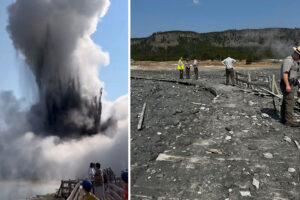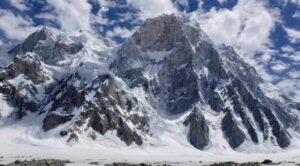As we previously reported, Corrado Pesce’s rescue operation ended on January 29, after a drone spotted his lifeless body in the snow. An avalanche on Cerro Torre had badly injured both Pesce and his partner, Tomas Aguilo. Aguilo managed to descend and was rescued, but Pesce’s injuries were so bad that he couldn’t move. When the weather closed in and prevented a helicopter from accessing that difficult spot, it sealed his fate.
Aguilo remains in the hospital, in stable condition. Meanwhile, the windy weather continues. The gusts are so strong that they even reach down to the city of El Chalten.
Earlier, Carolina Codo of the El Chalten Rescue Centre said that a group of Pesce’s friends planned to come to El Chalten to help recover his body. Today, climber-photographer Renan Ozturk confirmed on Facebook that Jonathan Griffith, a climber and close friend of Pesce’s, will attempt to recover his body during a short window later this week.
Earlier attempts failed, despite a huge community effort, because of the infamous Patagonia weather and the difficult location of the deceased climber.

Cerro Torre and Fitz Roy groups bathed in the last rays of the day. Photo: Jonathan Griffith
The Pou brothers: Why rescue is so hard on Cerro Torre
Elite climbers Eneko and Iker Pou told Explorersweb that when an emergency occurs in the mountains of El Chalten, there is little time to react. Weather windows are so short and shut so abruptly.
The other problem is that potential rescuers on the mountain are typically exhausted after their own demanding climbs. These needles are extremely difficult. Helicopters can’t pick up the climbers on the vertical walls.
Few practical routes exist for potential rescuers. Eneko Pou also says that for these climbers, it means having to repeat a dangerous climb on routes where maybe only a couple of people have previously succeeded.
However, in situations like this, everyone mobilizes — the Argentine rescuers, the army helicopter, and the climbers in Patagonia. Everyone tried to help Pesce, but his injuries were too grave, the mountain too unforgiving.

Cerro Torre. Photo: Roger Schaeli
A chronology of events
The Ragni di Lecco Alpine Club yesterday published a report written by Matteo Della Bordella and David Bacci. The two Italian climbers, and a third member of their group, Matteo De Zaiacomo, had climbed Cerro Torre on the same day as Corrado Pesce and Tomas Aguilo.
It began on Tuesday, January 25, at 11:30 am. Della Bordella, De Zaiacomo, and David Bacci went up the East Face of Cerro Torre, initially following the route opened by Cesare Maestri and Toni Egger in 1959, to the triangular snowfield. From there, they continued another five pitches to a small artificial shelter called the English Box. The box is now almost completely destroyed, and only a few crumpled sheets of metal remain. It no longer really offers any protection for climbers.
There, the three men placed their portaledge for the night. As they climbed, they saw Tomas Aguilo and Corrado Pesce fixing ropes on the first pitches of their route, about 150m from the line of Della Bordella’s group. They watched as Aguilo and Pesce then went back to their tent.

Cerro Torre. Photo: Matteo Della Bordella
Desperately hard work
On Wednesday, January 26, Della Bordella, Bacci, and De Zaiacomo were able to reach the British Diedre route after a strenuous day. This included some extremely difficult pitches where the face overhangs constantly and there is not the slightest ledge. They set their portaledge over the void. During the day, they saw Pesce and Aguilo advancing on their own line. Pesce and Aguilo stopped to bivouac on a ledge about 50m to the right of the English Box.
The next day, January 27, Della Bordella and his two companions traversed to the North Face of Cerro Torre. Here, they met Pesce and Aguilo. As both groups were climbing a new route and only 300m remained to the top of the tower, they decided to join forces for the final part. Pesce took the lead, followed by Aguilo and the three Italians.
At 5 pm, Pesce and Aguilo reached the top. Half an hour later, the three Italians joined them. The two groups congratulated each other on the summit. Moments later, their paths separated.

Matteo Della Bordella, Matteo De Zaiacomo, and David Bacci on the summit of Cerro Torre. Photo: Matteo Della Bordella
The two groups separate
Pesce and Aguilo decided to descend via the North Face. Della Bordella, Bacci, and De Zaiacomo preferred to spend the night on top and start their descent the following day along the southeast ridge, the so-called Compressor route.
On Friday, January 28, Pesce and Aguilo descended in the dark. Eventually, they reached the spot on the North Face where they had previously left their sleeping bags and bivy gear. They decided to rest at this point.
During those two hours of rest, the avalanche of ice and rocks hit them, seriously injuring Aguilo and leaving Pesce completely paralyzed.

Corrado Pesce guides Renan Ozturk up the Kuffner Ridge on Mont Maudit in the Mont Blanc massif. Photo: Alex Honnold
Della Bordella’s group knew nothing of what happened. On the morning of January 28, they began rappelling down the Compressor route. At 5 pm, they reached the glacier at the base of Cerro Torre, totally exhausted and at the limits of their strength.
Rescue of Aguilo
There, they discovered that something serious had happened. Another group of climbers on the glacier told them about Pesce and Aguilo’s accident. They learned that Aguilo had managed to descend until about 300m above the base. Meanwhile, Pesce was gravely injured and wasn’t showing any signs of life. His exact location was unclear. The Italian trio’s drone managed to pinpoint Aguilo but couldn’t find Pesce.
At about 6 pm, they started the rescue operation for Aguilo, under the leadership of Della Bordella. Together with Roger Schaeli, Thomas Huber, and Roberto Treu, they climbed seven pitches of the Italian route, up to the triangular snowfield, in about three hours. Huber coordinated the operations on the wall. The group traversed about 60m to reach Aguilo. It was already midnight. They managed to secure Aguilo, then Huber and Treu began to carry the stricken climber down.
Della Bordella and Schaeli stayed there with just one available rope. They tried to call Pesce, but there was no answer and they could not hear or see anything. Aguilo had told them that Pesce was about 300m higher. Schaeli and Della Bordella waited on the triangular snowfield until 3 am. By then, it was so cold that Della Bordella could not feel his feet, and he was feeling faint. For their own safety, they had to go down.

The dangerous upper section of Cerro Torre. In the last few days, its morphology changed a lot. Photo: Matteo Della Bordella
As Kelly Cordes wrote in his book, The Tower: ”Unlike other storied alpine ranges, the challenges of Patagonia have nothing to do with altitude…Nowhere on Mount Everest or K2 –- not even on their hardest routes –- nor on any of the alpine ice routes in the Alps, will you find such sustained vertical climbing as on Cerro Torre’s ‘easiest’ route.”
Kilian Jornet remembers Pesce
Kilian Jornet told Explorerweb: ”Korra was a really fantastic guy. On ice and alpine walls, he was one of the best in the world and a very discreet and humble person. The North Faces of the Grandes Jorasses were his second home. I don’t know how many times he climbed there…He was the one we called to ask for beta. It is a very big blow to alpinism.”
Matteo Della Bordella wrote on Instagram, “We had two parallel dreams: two new routes on Cerro Torre, running elegantly and directly on the east face and then on the north face. You [Pesce] were an alpinist, ‘all facts and no smoke’…In the rollercoaster of emotions that has hit me these days, there only remains deep sadness for the loss of one of the world’s best alpinists [and] a friend I admired.”
Della Bordella, Bacci, and De Zaiacomo called their route Brothers in Arms.






